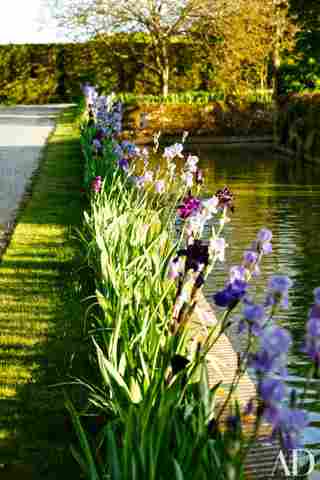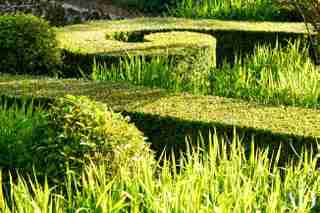Prince Stanislas Poniatowski and his wife, Leticia, purchased Château du Bois Hinoust , a centuries-old property in Cernay, France, as a country house to share with their children. The brick-and-stone structure was surrounded by a glittering moat and several underwhelming, awkwardly shaped acres with miles of remarkably flat farmland. Enter Louis Benech, French garden designer, who transformed the place into a gorgeous garden oasis with a mix of French formalism and a more naturalistic English approach.

Plant a variety of blooms year-round
There is a great progression of blooms throughout the year at the château: “Tulips in spring, roses in the summer, and then come the artichokes—and you have to decide whether to eat them or let them flower,” says Prince Poniatowski. Keeping seasons in mind guarantees a beautiful surprise.

Create symmetry
There were two layout issues that Benech recognized immediately—an eyesore of a swimming pool set far too close to the house and an adjoining square of lawn enclosed by boxwoods. His solution for the pool was to hide it from view behind a yew hedge, which helped even out the proportions of that section of the grounds. As for the boxwood square, Benech cut an opening into either end and extended outward with borders of shrubs and perennials to create a long thoroughfare that leads from the pool to the other side of the property. Now one can hardly tell the proportions were ever uneven.

Invest time and effort
The very best gardens benefit from two things—time and harmonious human relationships. Le Bois Hinoust’s landscape has had both. Benech returns regularly to monitor the garden’s progress, visits that have deepened his friendship with the Poniatowskis.
Connect two areas with flowers
Eventually a next-door plot became available, so the couple acquired it, too. At first the prince says he considered planting wheat or another agricultural crop, then Benech proposed the idea of flowers. In spring and summer the added acreage becomes a riotous carpet of white Shasta daisies and purple dame’s rocket; now the flowers seem to flow into the farmland from the home.
Use textures symbiotically
Grapevines blanket a teak pergola, shading red ‘Madame Isaac Pereire’ roses and purple ‘Jackmanii Superba’ clematis; the arch beyond is draped with ‘Multijuga’ wisteria and more ‘Madame Isaac Pereire.’ In another area, the designer emphasized texture, choosing species with variegated foliage and interesting shapes and avoiding plants that need constant pruning. The result is a unique yet complementary bouquet of plants.
